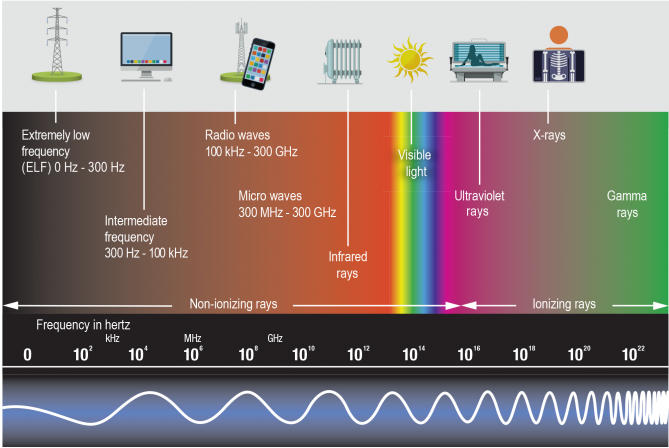

Household appliances, computers, mobile phones, microwave ovens, hair dryers, GSM (antennas), power lines...: we are surrounded by appliances that emit electromagnetic fields and radiation.
Recently there has been a lot of talk about the arrival of the 5G network and the smart meter. Nevertheless, we were already constantly exposed to electromagnetic fields and radiation well before then.
| Moreover, these phenomena were already present long before the arrival of human technology: the earth's electromagnetic field, UV radiation from the sun, light and lightning are natural manifestations of fields and radiation. |
Briefly, an electromagnetic field results from the combination of an electric field and a magnetic field.
Remember your physics classes: when electrical charges are present, they interact with each other. Depending on their nature, they repel or attract each other. This effect of attraction or repulsion produces an electric field, measured in volts per metre (V/m).
Electric fields exist in nature (thunderstorms are a visible manifestation of this!) but are also generated by our electrical appliances. In concrete terms, as soon as it is energized, any conducting wire generates an electric field.
A magnetic field (measured in Microtesla or µT) appears when a current flows and electrical charges are set in motion.
| Electric field | Magnetic field | |
| Generated by: | A potential difference between electrical charges | Electrical charges in motion |
| Measured in: | Volt/metre | Microtesla |
| Intensifies with: | Voltage | The number of amperes |
Electromagnetic fields differ from one another. For example, depending on whether it is produced by a household electrical appliance or an x-ray machine, the electromagnetic field will not have the same characteristics or effects.
Electromagnetic fields are generally classified according to two interdependent criteria:
The higher the frequency, the shorter the wavelength. And vice versa.

© Elia
The electromagnetic spectrum allows you to view the different types of electromagnetic fields from the lowest frequencies and the longest wavelengths to the highest frequencies and the shortest wavelengths.
At the far left of the spectrum are high-voltage lines, our electrical appliances, television, radio, microwave ovens, radar and mobile phones and infrared rays that generate so-called 'non-ionising electromagnetic fields.
In other words, their frequency is low (below the threshold of 1015 Hz) and the energy they carry is insufficient to break molecular bonds and produce ions (hence their name).
Visible light also falls into this category. UV is located at the margin between electromagnetic fields and ionizing radiation.
At very high frequencies, on the other hand, electromagnetic fields propagate in wave form at the speed of light. This is called radiation. This radiation carries so much energy that it is capable of breaking the chemical bonds between molecules and thus damaging living cells.
Think of, for example, certain ultraviolet rays, X-rays, gamma rays... Their source can be natural (sun, radioactive substances...) or artificial (X-ray machine, UV lamp...).
With regard to non-ionising electromagnetic fields, the scientific community has not yet reached a consensus on possible health effects.
However, some studies, based on statistical reports, point to an increased risk of cancer with long-term exposure to low-frequency electromagnetic fields emitted by high-voltage power lines, particularly in children. However, a causal link has not been clearly established to date.
A precautionary principle is therefore applied to determine acceptable standards and thresholds.
| In Brussels, the standard governing exposure to radiation of transmitting antennas in public places may never exceed 0,096 W/m2 or 6 Volt per metre (6 V/m), at a reference frequency of 900 MHz. That is more than in Flanders or Wallonia and even makes the Brussels standard one of the most stringent in the world (50 times stricter than recommanded by the World Health Organisation). |
By comparison: when using your mobile phone, exposure will be 10 times higher, i.e. about 50 to 60 V/m! In other words, even if you live near a transmitting aerial, thanks to the Brussels standard, exposure will be a lot less than when you make a call with your mobile phone.
Subscribe to our newsletter and stay informed about energyfacts.